California’s only endemic elk, Cervus candensis nannodes can be found at Point Reyes National Seashore and 21 other areas of California. This is remarkable for a species that was once thought to be extirpated.
Family structure for the tule elk, the smallest of all American elk, is based on the bull commanding a herd, known as a harem, of cows and calves. From July through September is the rutting season, when males are competing by rounding up large harems of females and calves.
In the early morning hours it is easy to hear their bugling calls through the fog on the Point Reyes grasslands.
Point Reyes is located 30 miles north of San Francisco, a coastal wilderness park of 100 square miles. It is my favorite place to hike in the Bay Area, and is the only U.S. National Park that has tule elk.
The best place to view the elk is at Pierce Point Ranch, and after many, many years of hiking this picturesque area, I have found early mornings are best for finding the elk. As it is a stunning place, I will post more on Monday, featuring other wildlife we have enjoyed there.
Photos here are from two weeks ago. We were rewarded with incredible views of bull, cow, and calf groups.
We had been watching and photographing for about a half hour, when the additional excitement of four angry bulls converged in front of us. An elk showdown.
There was a lot of bugling, pacing, trotting, and flared nostrils; but no sparring.
Bugling starts out as a bellow and escalates into a squealing whistle. It is the bull attracting cows as well as advertising dominance to other bulls.
Once numbering 500,000 in California, the species declined drastically due to cattle ranching and hunting. The species population had reduced to 29 individuals by 1860.
They were thought to be extirpated when a rancher, Henry Miller, found a herd on his ranch in 1874. Mr. Miller protected them and is credited for the survival of the species.
Named for a sedge grass called tule, the elk have had a series of successful reintroduction programs, and number at about 4,200 today.
More about tule elk at Point Reyes here.
Usually quietly grazing, the elk are a joy to observe any time of year, but right now it is especially animated with bellowing and squealing, pacing and competing. And with a backdrop of the Pacific Ocean, it is a true splendor.
Photo credit: Athena Alexander
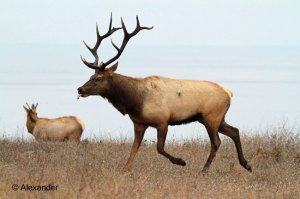

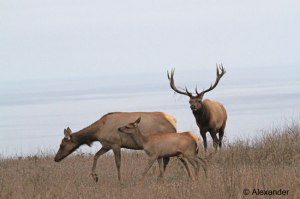
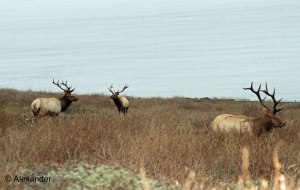
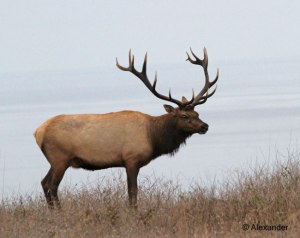
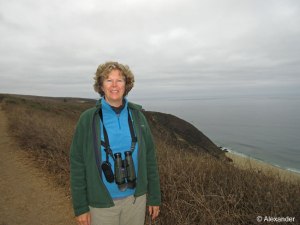
Beautiful Elk ❤️👍🏻
Thank you John, and thanks for stopping by.
Elk are so animated in September.
They sure are, Craig. We came across a herd right on the trail, and they are big! Glad to see you, have a great weekend.
How incredible to watch a bull-elk showdown right in front of you – what an amazing experience (from a safe distance of course)!😃
When we get out there early, we see so much more action, espec. at this time of year. It was incredible. We were in the car with the open sun roof. Thanks so much Joanne!
Oh, they are gorgeous! Is moose and elk the same?
Good question, Trini. Moose and elk are a little confusing outside of North America because in Europe moose (Alces alces) are called elk. In the U.S. moose have flat noses, and elk, aka Cervus canadensis, are a completely different species. I’m glad you enjoyed the tule elk today my friend~~
Athena’s capture of the elk bugling is amazing! I think I can hear the call through my screen if I tilt my ear just right. What gorgeous animals they are.
On another note we have just booked tickets to be in the bay area the first week of Dec. If you and Athena are going to be in town we would love to try to meet at some point. If that is something that might work don’t hesitate to email at traveltalesoflife@gmail.com
Have a great weekend!
Hi Sue. I’m really glad you enjoyed the elk post today, and I smiled at your hearing the bugling. I would be delighted to meet up when you visit the Bay Area. Thanks for the email, I will connect with you there. yippee!
Great! Hopefully we can make something work.
I would like that very much, Sue~~
What a beautiful animal!Those antlers are huge…interesting information and wonderful photo’s,Jet!
It’s amazing how big those antlers are, Dina. And really fun to watch them scratching the tips in the dirt, coming up with grass clumps. The antlers remind me of chandeliers. It would be like walking around with a crystal chandelier on your head. Thanks for stopping by today~~
Love these photos, Jet. They are in the Bay area and only 30miles fro SF, I’m so surprised. 🙂
Beautiful creatures. Enjoyed reading the info.
Even though it’s only 30 miles, it’s about a 1.5 hr drive with traffic. If you’re coming from SF it’s best to set aside a full day. But what a wonderful way to spend the day! So glad you enjoyed the elk today, Amy —
Thank you, Jet!
🙂
I love elk, particularly their Bugle 🙂 so ethereal…so beautiful!
That’s a wonderful description of the bugling elk, Morgan — the sound is indeed ethereal…especially when the fog obscures the view, but you still hear the call. Thanks for your comment~~
Jet,
this conversation, and your beautiful images just inspired a poem that I would love to share and link back to your original post as it’s inspiration. IF you are willing to give your kind permission?
I would be honored and delighted, Morgan. 🙂
Thank You Jet 🙂 It will post tomorrow 🙂
And thank You for Inspiring me 🙂
I hope you like it
A pleasure for me, too, Morgan — I will check it out tomorrow. 🙂
Amazing! I didn’t even know we had elk!
It’s a wonderful thing, isn’t it, Cindy? Per Wikipedia: “Tule elk can reliably be found in Carrizo Plain National Monument, Point Reyes National Seashore, portions of the Owens Valley from Lone Pine to Bishop, and on Coyote Ridge in Santa Clara Valley, San Jose, California.” I have extensively visited Carrizo but have only seen them at Pt. Reyes. 😀
I’ve never seen an elk in the wilderness only in an animal park. They are really impressive animal. Wow, what a encounter! 🙂
It is such a fantastic site to come across the wild elk, Simone. You never know when they will be close enough to photograph, but I have found over the years that I’ve had more luck in the early mornings. I’m really glad to have shared the elk with you.
🙂
Amazing article. Great photos too.
Thanks very much, Tareau. 🙂
Great post. The photo of the lone elk with the ocean in the background, showcasing its antlers, is amazing!
We were lucky that day there was no fog and the ocean was the background. In the spring the grass is green, and that is nice during that season. I’m really glad you enjoyed the elk post, thank you for commenting.
Fantastic photos! How wonderful to have such a beautiful place close to home where you can hike along the ocean and watch these amazing animals.
You hit it, ACI. I feel so very fortunate to be within driving distance of Pt. Reyes, so glad that such a beautiful place exists. I go there often, and have for over 25 years.
I love that you got a photo of one with his tongue out!
That’s a fun one, isn’t it Diana? Thank you for your comment and visit~~
They’re magnificent!! I had to chuckle at the first one sticking it’s tongue out 😉
Isn’t that a fun photo, Sarah? Gave me a chuckle too, I’m glad it did for you as well. Thanks so much~~
My pleasure Jet 🙂
Breathtaking. Thanks for another beautiful adventure, Jet. Hugs.
Thanks so much, Teagan, for joining us on the adventure…a joy. 🙂
Beautiful animals! You live close to so many good places! Lucky 1%? Great post my friend! 🙂
I live in the congested Bay Area, where there is a lot of beauty, but also a lot of people and traffic. I don’t consider myself part of a lucky percentage, but merely focus on the beauties. I’m really glad you enjoyed the elk post today, HJ — always fun.
Truly a magnificent animal! How fortunate you got to witness the group “dynamics.”
We made a special effort to book a room as close to the elk as possible, and then got up and on the road soon after the sun rose. That turned out to be the ticket, for an Aug. visit. They are truly magnificent, I’m glad you enjoyed the tule elk, Jan.
I have never read about these earlier! thanks so much for sharing. Looks adorable! 🙂
I’m glad you enjoyed the tule elk, quirkywanderer. Thanks for stopping by.
Pingback: Discordant Beauty – #Poetry of the #NaturalWorld | Booknvolume
Thanks so very much, Morgan — it is a delight to be part of the inspiration for your lovely poem.
I’ve never seen elk, Jet. I can only imagine the emotions you were feeling when you saw and captured them with your camera.
Thanks so very much, Amy. I am happy you enjoyed the elk photos and post.
Beautiful photos (esp of you, Jet). Sounded like a wonderful experience. I googled Tule Elk bugling and heard the sound they make. WILD !!! You described it well. Thank you.
Dear Nan, I am very glad you were able to tune into the striking, sometimes haunting, sounds of the tule elk’s bugling. Thanks so much for stopping by.
Lucky you to be there and capture the elk moments! Lucky me for reading this post today. Thanks Jet 💛
It works out for both of us, doesn’t it Val? I am pleased you enjoyed the elk moments, and I look forward to sharing more of the wildlife of Tomales Point with you on Monday. Until then, have a lovely weekend~~
Wonderful post and Athena’s images add so much. I get quite a few sightings out here, but I understand that we have the Roosevelt Elk (the largest of the bunch) here West of the Cascades. One particular sighting that I won’t forget in a hurry was pretty recent. Driving through the ‘gully’ at Humbug Mountain, a bull jumped up from a creek bed, crossed the road within a few feet of my bumper and continued on up a steep hillside. That was quite an adrenalin rush. Another time I was hiking in Utah in the fall. We could hear the elk crashing through the thick brush. We never did get to see how they managed to move so fast through the thick growth, but we could certainly hear them. They are certainly amazing creatures.
Great elk stories, Gunta. Beautiful animals, and yes, amazing. Their size is impressive. And those Roosevelt Elk are huge. I can imagine what a crash you must have heard as they ran through the brush. Always a delight when you stop by~~
Hi Jet – I saw your comment on Sue Slaght’s blog, so took a wander over to yours – and what a delightful find! You write about my passions: wildlife and travel… I shall be back. 🙂
Susan at
Travel, Fiction and Photos
i have found some great friends on Sue’s blog, she’s such a lively host, isn’t she? Thanks for the kind message, Susan, I will hop on over to see your delights.
thank you for bringing back
out to pt reyes, Jet!
great shots!
i recall seeing those elk
through the fog
and not having
a camera 🙂
And even without a camera you remember the elk—that’s how remarkable the sight is. Thanks so much for your visit and lovely words, Dave. A pleasure to bring you back to beautiful Pt. Reyes. Tomorrow’s post is a follow-up to the elk, with other wildlife of Tomales Point.
What a wonderful post, Jet! Beautiful pictures by Athena, and your descriptions of tule elk behaviour, and the encounters you had were great to read. Particularly enjoyed reading about the bugling – it all sounds rather exhausting to be an elk this time of year, cow or bull…
Well done to Mr. Miller way back when, and what an adventure – looking forward to tomorrow!
I am smiling after your comment, pc — thanks so much for the thoughtful visit here. I suspect it is rather exhausting to be an elk this time of year…a new thought for me (with a smile). I, too, was inspired by Mr. Miller. So many ranchers, espec. back then, would have shot the elk; Mr. Miller was a conservationist and gentle man — truly an inspiration.
Jet, do elk shed their antlers similar to deer? Interesting story on the Tule elk
Yes, male shed their antlers every year. Here’s more info if you would like, SWI: go to TuleElkSNRWWebBrochure2012Rev.pdf. Thanks for stopping by.
Thank you, Jet
🙂
Magnificent animals! Wonder if they are closely related to the elk you find in and around Banff and Waterton National Park? They look very similar.
Yes the tule elk and elk of Banff are related, they are the Cervus canadensis species. They truly are magnificent animals, you are right. I’m glad you enjoyed the tule elk post, Inger.